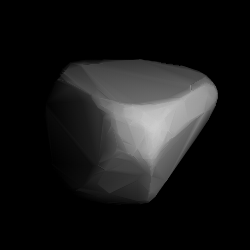6882 Sormano
Topic: Astronomy
 From HandWiki - Reading time: 4 min
From HandWiki - Reading time: 4 min
 Shape model of Sormano from its lightcurve | |
| Discovery [1] | |
|---|---|
| Discovered by | P. Sicoli V. Giuliani |
| Discovery site | Sormano Obs. |
| Discovery date | 5 February 1995 |
| Designations | |
| (6882) Sormano | |
| Named after | Sormano Observatory (discovering observatory)[2] |
| 1995 CC1 · 1986 XM2 1989 OW · 1993 OQ | |
| Minor planet category | |
| Orbital characteristics [3] | |
| Epoch 4 September 2017 (JD 2458000.5) | |
| Uncertainty parameter 0 | |
| Observation arc | 27.85 yr (10,173 days) |
| |{{{apsis}}}|helion}} | 2.8043 AU |
| |{{{apsis}}}|helion}} | 2.2997 AU |
| 2.5520 AU | |
| Eccentricity | 0.0989 |
| Orbital period | 4.08 yr (1,489 days) |
| Mean anomaly | 327.31° |
| Mean motion | 0° 14m 30.48s / day |
| Inclination | 14.390° |
| Longitude of ascending node | 284.19° |
| 16.030° | |
| Physical characteristics | |
| Mean diameter | 6.69 km (calculated)[4] 7.665±0.101 km[5] 8.096±0.040 km[6] |
| Rotation period | 3.6901±0.0006 h[7] 3.998344±0.000001 h[8] |
| Geometric albedo | 0.21 (assumed)[4] 0.269±0.034[6] 0.3003±0.0545[5] |
| S (family-based)[4] | |
| Absolute magnitude (H) | 12.5[5] · 12.7[3] · 12.736±0.003 (R)[7] · 13.19[4] |
6882 Sormano (prov. designation: 1995 CC1) is an stony Eunomia asteroid from the middle region of the asteroid belt, approximately 7 kilometers (4.3 miles) in diameter. It was discovered on 5 February 1995, by Italian amateur astronomers Piero Sicoli and Valter Giuliani at Sormano Astronomical Observatory in northern Italy.[1] The asteroid was named for the Italian mountain-village of Sormano and its discovering observatory.[2]
Orbit and classification
Sormano is a member of the Eunomia family, a large group of S-type asteroids and the most prominent family in the intermediate main-belt. It orbits the Sun at a distance of 2.3–2.8 AU once every 4 years and 1 month (1,489 days). Its orbit has an eccentricity of 0.10 and an inclination of 14° with respect to the ecliptic.[3] The asteroid's observation arc begins 6 years prior to its discovery, as it had previously been observed as 1989 OW at Palomar Observatory in 1989.[1]
Naming
This minor planet was named in honor of the Italian mountain-village of Sormano and its discovering nearby observatory. It is funded, built and operated by the "Gruppo Astrofili Brianza", a group of Italian amateur astronomers who have discovered numerous minor planets.[2] The official naming citation was published by the Minor Planet Center on 3 May 1996 (M.P.C. 27130).[9]
Physical characteristics
Rotation and shape
In September 2010, a rotational lightcurve of Sormano was obtained from photometric observations made at the Palomar Transient Factory in California. It gave a rotation period of 3.6901 hours with a high brightness variation of 0.71 magnitude, indicative of a non-spheroidal shape ({{{1}}}).[7] A similar period of 3.998 hours was derived from remodeled data of the Lowell photometric database (n.a.).[8]
Diameter and albedo
According to the survey carried out by NASA's Wide-field Infrared Survey Explorer with its subsequent NEOWISE mission, Sormano measures 7.6 to 8.0 kilometers in diameter and its surface has an albedo between 0.269 and 0.300.[5][6] The Collaborative Asteroid Lightcurve Link assumes an albedo 0.21 – derived from 15 Eunomia, the family's largest member and namesake – and calculates a diameter of 6.69 kilometers with an absolute magnitude of 13.19.[4]
References
- ↑ 1.0 1.1 1.2 1.3 "6882 Sormano (1995 CC1)". Minor Planet Center. https://www.minorplanetcenter.net/db_search/show_object?object_id=6882.
- ↑ 2.0 2.1 2.2 Schmadel, Lutz D. (2007). "(6882) Sormano". Dictionary of Minor Planet Names. Springer Berlin Heidelberg. p. 563. doi:10.1007/978-3-540-29925-7_6162. ISBN 978-3-540-00238-3. https://archive.org/details/dictionaryminorp00schm.
- ↑ 3.0 3.1 3.2 3.3 "JPL Small-Body Database Browser: 6882 Sormano (1995 CC1)". Jet Propulsion Laboratory. https://ssd.jpl.nasa.gov/sbdb.cgi?sstr=2006882.
- ↑ 4.0 4.1 4.2 4.3 4.4 4.5 4.6 "LCDB Data for (6882) Sormano". Asteroid Lightcurve Database (LCDB). http://www.minorplanet.info/PHP/generateOneAsteroidInfo.php?AstInfo=6882%7CSormano.
- ↑ 5.0 5.1 5.2 5.3 Mainzer, A.; Grav, T.; Masiero, J.; Hand, E.; Bauer, J.; Tholen, D. et al. (November 2011). "NEOWISE Studies of Spectrophotometrically Classified Asteroids: Preliminary Results". The Astrophysical Journal 741 (2): 25. doi:10.1088/0004-637X/741/2/90. Bibcode: 2011ApJ...741...90M.
- ↑ 6.0 6.1 6.2 Masiero, Joseph R.; Grav, T.; Mainzer, A. K.; Nugent, C. R.; Bauer, J. M.; Stevenson, R. et al. (August 2014). "Main-belt Asteroids with WISE/NEOWISE: Near-infrared Albedos". The Astrophysical Journal 791 (2): 11. doi:10.1088/0004-637X/791/2/121. Bibcode: 2014ApJ...791..121M. http://adsabs.harvard.edu/cgi-bin/bib_query?bibcode=2014ApJ...791..121M. Retrieved 4 November 2016.
- ↑ 7.0 7.1 7.2 Waszczak, Adam; Chang, Chan-Kao; Ofek, Eran O.; Laher, Russ; Masci, Frank; Levitan, David et al. (September 2015). "Asteroid Light Curves from the Palomar Transient Factory Survey: Rotation Periods and Phase Functions from Sparse Photometry". The Astronomical Journal 150 (3): 35. doi:10.1088/0004-6256/150/3/75. Bibcode: 2015AJ....150...75W. http://adsabs.harvard.edu/cgi-bin/bib_query?bibcode=2015AJ....150...75W. Retrieved 4 November 2016.
- ↑ 8.0 8.1 Durech, J.; Hanus, J.; Oszkiewicz, D.; Vanco, R. (March 2016). "Asteroid models from the Lowell photometric database". Astronomy and Astrophysics 587: 6. doi:10.1051/0004-6361/201527573. Bibcode: 2016A&A...587A..48D. http://adsabs.harvard.edu/cgi-bin/bib_query?bibcode=2016A&A...587A..48D. Retrieved 4 November 2016.
- ↑ "MPC/MPO/MPS Archive". Minor Planet Center. https://www.minorplanetcenter.net/iau/ECS/MPCArchive/MPCArchive_TBL.html.
External links
- Lightcurve Database Query (LCDB), at www.minorplanet.info
- Dictionary of Minor Planet Names, Google books
- Asteroids and comets rotation curves, CdR – Geneva Observatory, Raoul Behrend
- Discovery Circumstances: Numbered Minor Planets (5001)-(10000) – Minor Planet Center
- 6882 Sormano at AstDyS-2, Asteroids—Dynamic Site
- 6882 Sormano at the JPL Small-Body Database
 |
 KSF
KSF